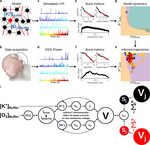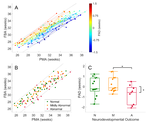Better infant brain monitoring
Last updated on
29 May 2020

In neonates, we use techniques from physics and machine learning to extract more information than ever before from intensive care monitoring of babies born prematurely. The goal is to enable early detection of injuries and early prognosis of developmental outcomes, so that clinicians can optimise care with personalised markers of brain health, potentially opening the window for new treatments.
Posts
New paper: A growth chart of brain function from infancy to adolescence based on EEG
Functional brain age derived from EEG is an accurate, practical and scalable automated tool to track brain function maturation throughout childhood with accuracy comparable to widely used physical growth charts.
New paper: Mechanisms underlying pathological cortical bursts during metabolic depletion
Disruption to the brain’s oxygen supply triggers pathological dynamics and brain injuries. A model of coupled metabolic-neuronal activity generates burst suppression patterns similar to those of infants after birth asphyxia.
New paper: Reliability and accuracy of EEG interpretation for estimating age in preterm infants
Our computational functional brain age (FBA) measure outperforms human raters
FBA paper published!
Functional brain age can be estimated using EEG from preterm babies to within ±1 week.



